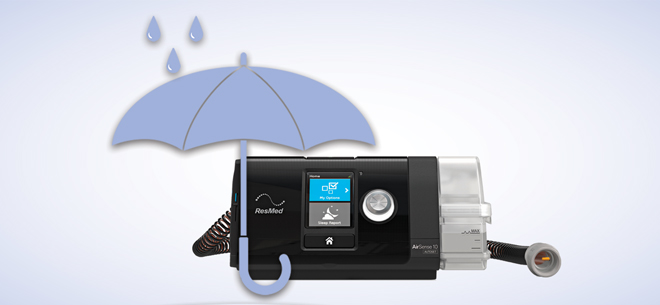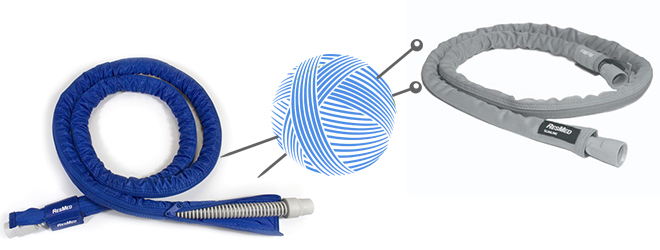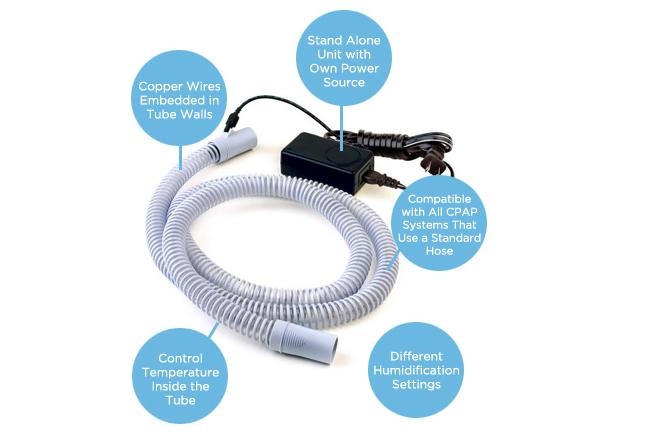
You’d be hard pressed to find one person that enjoys the experience of getting rained on while in that happy, cozy, fuzzy dream place that we drift off to when we sleep. Let’s leave the combination of water and sleeping to the fish, shall we? If you are getting rained on, there is a good chance that you are experiencing a common CPAP issue known as rainout. No, it’s not a recurring dream – your CPAP machine is, in effect, raining on you. Rainout occurs when the temperature of the room is colder than the temperature of the humidified air traveling through your hose. Think of a window in a warm room or a cold beverage on a hot day. Eventually, all that built up condensation in your CPAP hose will start splashing you in the face. Yes, it’s terrible. Here are three sure fire solutions to your rainout conundrum.
1. Use a CPAP Machine With A Heated Hose
Sometimes, a streamlined system can be a better and more efficient system – you don’t have to deal with buying all those extra parts and components. This is why purchasing a CPAP machine that comes with a heated hose is such a smart idea and investment. If you know that you want the added soothing power of a humidifier, purchasing an all-inclusive CPAP system is undoubtedly the best route to go. For instance, the AirSense 10 Autoset with HumidAir and ClimateLineAir Tube from ResMed is an auto-pap machine that comes with a heated humidifier and a climate controlled hose – basically, the hose uses internal sensors to control the temperature, so that rainout never becomes a problem. The brand new DreamStation Auto CPAP with Humidifier and Heated Tube. When it comes to rainout, it can be nice to simply nip the issue in the bud – easy-peasy-lemon-squeezy, as they say.
2. Use a Hose Wrap or Cover
Everything is better with a thick, cozy pair of socks on, right? Well, the same concept applies to your CPAP hose. One of the best ways to solve the rainout problem is to purchase a CPAP hose wrap or cover, which will effectively keep your hose insulated from the ambient temperature of your room. For instance, the SlimLine Tubing Wrap and Tube Wrap/Cover are both incredibly effective at doing just that. If you can’t find a hose wrap or cover that works for your specific CPAP system, you may want to think about wrapping your hose in a towel or washcloth to prevent condensation. You could even ask your grandmother to knit you a CPAP hose cover if you really wanted to.
3. Pick Up An After-Market Heated Hose
Another option – if your CPAP doesn’t already come with a heated hose – is to purchase an after-market climate controlled hose. There are many after-market hoses to choose from, like the Hybernite Rainout Control System, which is unique because it is powered by an independent source of electricity and it is compatible with most humidifiers, which means that it is incredibly versatile.
In the end, no one likes to be rained on while asleep, which is why you want to tackle your rainout problem head-on. Even if you aren’t experiencing rainout just yet, you may want to think about purchasing a heated hose – for the sake of preventing rain out and for the sake of preventing a future problem. All that water splashing on you can end up keeping you up at night and it can dissuade you from sticking to CPAP treatment. At the end of the day, you probably wouldn’t leave the house without an umbrella when its raining cats and dogs outside – so, why wouldn’t you use a heated hose to help insulate CPAP hose?
Bonus Tips: Try Adjusting Your Humidifier Settings and the Temperature of Your Bedroom
Basically, the reason why water is collecting in your tube and mask is because there is a temperature difference between the air around your CPAP and the air flowing through your CPAP.
If you think that the air in your room is hotter than the air in your CPAP (imagine a sweaty summer night):
- Decrease the temperature of your room (try putting a fan near your bed or turning on the air conditioning)
- Increase the humidity of your CPAP
If you think that the air in your room is colder than the air in your CPAP (think of those cold winter evenings):
- Increase the temperature of your room (turn on the heat)
- Decrease the humidity of your CPAP













